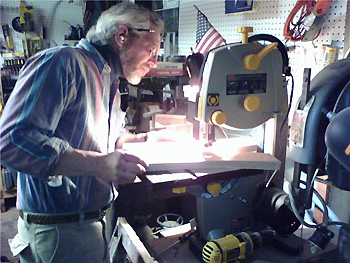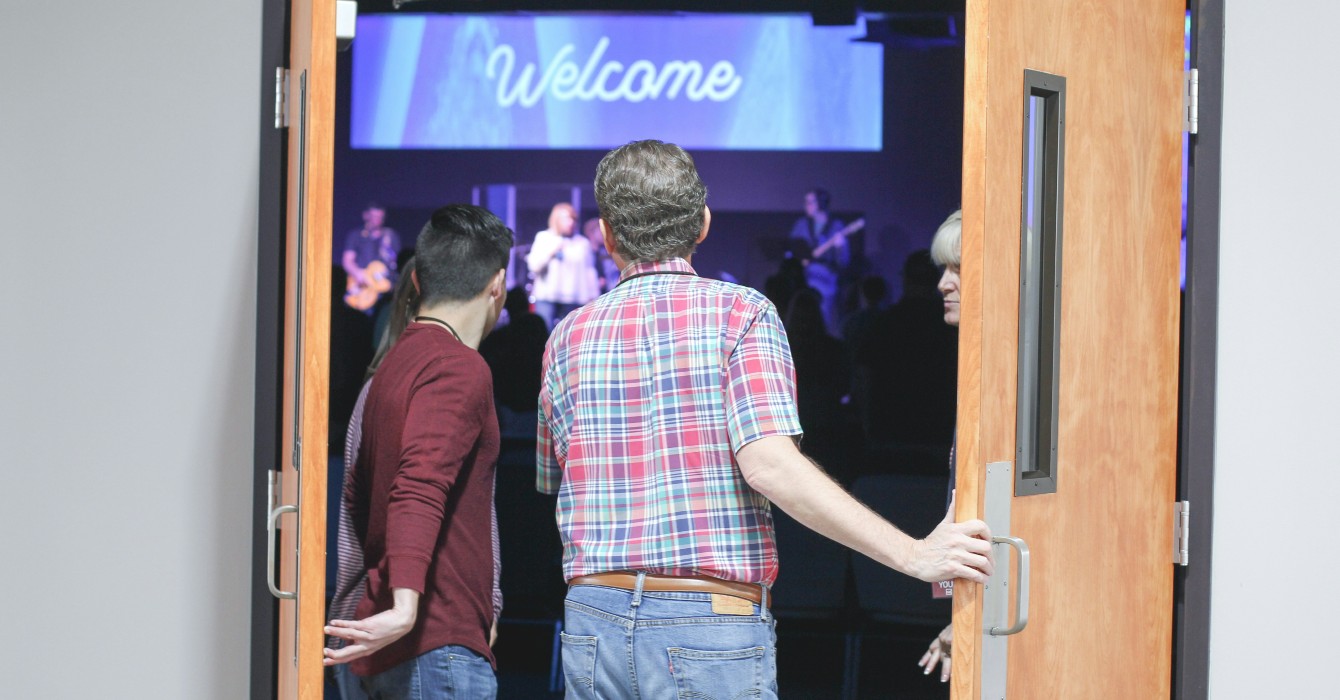In June 2007, a group from New Wilmington Presbyterian Church traveled to New Orleans to help rebuild. Midway through a three-hour drive around the city, they hadn’t seen one functional fast-food restaurant, ice cream shop or grocery store. Two years after Hurricane Katrina, they still found gutted homes, empty streets and even a steel wall hanging from a tree.
The group drove for miles without seeing anyone. Then they passed a man on a cul de sac who mouthed, “Thank you for coming,” as they drove past.
“I left wondering, ‘Who does he tell his story to at the end of the day?’” said the Rev. Lisa Nichols Hickman, associate pastor. They turned around to talk with the man, and when the conversation ended, he said something they would hear many times during their trip: “Don’t forget us. Tell our story.”
They heard it from the pastor who housed the volunteers in his church. They heard it from a teenage storm victim. And they heard it from this man standing alone on a road in a seemingly deserted city.
A new mission
For Hickman, the plea became an invitation for a new mission. A writer who grew up in Louisiana, Hickman decided her group should offer to help New Orleans -- not with wallboard or work gloves -- but with words. They would tell the story of the Gulf Coast and its people after the storm.
Members of the church returned to their home in New Wilmington, Penn., when their original work week was finished. But seven months later, a new group returned with a new mission. Their finished product is a 60-page booklet of essays, poetry and prayers written from people ages 9 to 90, children’s books, a pen pal project, a blog and videos on YouTube.
Questions to consider
Questions to consider:
- How has your life been changed by the stories you have experienced, heard and told?
- Who are the people whose stories you need to hear? What are the stories you need to tell?
- When leaders need to find new stories and new ways forward, they must articulate new scripts, according to authors and educators Nick Nissley and Stedman Graham. What old scripts might be hindering your leadership’s effectiveness?
- What new scripts might transform your leadership and the capacities of those whom you lead?
The process of writing and creating videos also was important, Hickman said. The project united the 600-member congregation, using the skills and gifts of each of the volunteers. A fourth grade teacher facilitated a pen pal project between her class and students in New Orleans; a librarian helped high school students work with younger students to write children’s books; a teen led her peers in making videos.
And now, even after the end of the storytelling project, its spirit continues in an ongoing effort to build tables for people who lost furniture in the storm. And for those in New Orleans, the project is an inspiring record of both the destruction and the progress the city has made.
“So often in churches we fill functions and staff programs instead of living our strengths,” Hickman said. “In this mission project, people were able to use their strengths to their fullest capacity.”
‘Does it make a difference?’
When Hickman returned to New Orleans in January 2008, she brought with her about 30 adults and youth from the church, along with “Praying Like Jesus” author James Mulholland, who led a writing workshop. The teens had several jobs. They made videos, helped fourth- and fifth-grade charter school students write children’s books and worked on their own writing.
The writing was tough. They were afraid and nervous because they wanted to honor the people of New Orleans, Hickman said. Mulholland instructed them not to focus on a final product, but to let the words fall from their hearts.
One student, Alex Taylor, wrote about a New Orleans fourth grader who marveled at the metallic purple nail polish on her fingernails. The girl’s eyes sparkled when she talked about Hannah Montana. But she also confided to Taylor that her house had burned down, her father was in jail and her dog had died not long ago:
“The people of New Orleans inspire me. Although they have lost a lot, they keep an optimistic outlook which motivates them to rebuild and restore their lives,” Taylor wrote. They ‘show me the importance and value of being optimistic.’”
In New Wilmington, members of the community who didn’t go to New Orleans became writing partners. A retired music professor wrote a spiritual. Margaret McKee, a retiree in Hickman’s church, wrote a prayer:
“It’s hard Lord, letting this pew go. I know; it isn’t safe any more after sitting in the waters so long. But, Lord, it holds so many memories for me. The new pews will be lovely -- all shiny and new. And my church family will still be here around me. But you know, it won’t be quite the same any more.”
The teens on the trip worked with two audio-visual technicians to put together short videos they called “WOOT” -- We Offer Our Testimony. Modeled after the NOOMA videos produced by Rob Bell, pastor at Mars Hill Bible Church in Grandville, Mich., they use Scripture, metaphor and testimony, Hickman said.
Addie Domske, a high school senior who led the project, wrote an essay in which she asked: “Can iMovie make a difference in the effort to help in NOLA?”
“The whole experience led me to think about how we make a difference in the world…Does it make a difference to travel that far just to sit and make movies? Can I, as an 18-year-old high school student, make a difference? Does it make a difference to rebuild New Orleans at all, when there is such a risk of our work being undone?
The consistent answer I found: yes.”
After the New Wilmington group returned home, fourth graders from both places became pen pals. The teacher in New Wilmington encouraged her kids to explore the topic “Don’t give up.” The theme “Don’t give up” derives from the Cajun Potato dance, a two-step in which the dancers hold a potato between their foreheads. L’ache pas la patate, which literally means, “Don’t let the potato drop,” is Cajun slang for “Don’t give up.”
Reflecting on the experience, Hickman wrote:
“The phrase opened up the conversation of perseverance. While the teachers at the Wilson Charter School, not wanting to stir up the fragile emotions of its students, asked us to not explicitly talk about Katrina, we were able to talk about not giving up. Deepened in this conversation was community and the power of articulation within a community that encourages those discouraged to not let the potato drop.”
The people of New Orleans were not the intended audience for the project. Hickman’s hope was that people who may have forgotten about New Orleans would read the booklet or watch the videos.
Still, the effort gets high praise from those working in the Crescent City. Robin Keegan, deputy director of the Louisiana Recovery Authority, says the group left behind a different lens into the city’s story. Keegan said it was inspiring -- not only because it shows how much work still needs to be done, but also because it highlights what progress has been made.
Building tables, rebuilding lives
The storytelling project continues in a new form in woodshops around New Wilmington, where workers are sawing, sanding and pounding nails in another effort to help people on the Gulf Coast.
New Wilmington Presbyterian Church member Jim Moose hadn’t gone on the mission trips, but he wanted to contribute in some way. Moose, a furniture designer, first thought of helping to replace damaged pulpit/communion tables, but the idea didn’t take hold.
Then he heard about a teacher who moved into a home built by Habitat for Humanity. Each piece of furniture in the house had been donated, Hickman told Moose, and the woman was crying because for the first time in several years, she had a kitchen table, Moose recalled.
“I’m standing there in tears,” Moose said of hearing the story. “Those of us who haven’t been through a natural disaster don’t understand what it’s like to have the only thing you have left is a shell of a house.”
The story inspired him. He came up with the idea of building trestle tables that could be broken down, shipped and put back together easily. The project took off immediately. Already 120 tables have been shipped to the Gulf Coast region and Moose predicts he and his army of volunteers will make between 350 and 500 tables this year through the Western Pa Table Project.
“In my 52 years, I have never done anything that felt like it mattered like this does,” Moose said.
The first person to receive a table was an 82-year-old man. In a thank-you letter, the man’s daughter wrote that the table “will remind us what a blessing it is to give to others that are less fortunate than ourselves.”
“Prayerfully the table will remain in our family for years to come, and we can pass the history of the table to our future generations,” she wrote.
Hickman loves the idea of building tables because “the story of our faith is told at the table… When I consider bread being broken in the homes of those who receive the tables, I know that communion is happening as an extension of the church.”
Spreading the message
Not far from New Wilmington, Alice Otto, a member of Highland Presbyterian Church in nearby New Castle, Penn., heard at a worship service about the church’s efforts. The message was so inspiring that she and others are trying to figure out how they can build a relationship with members of a Pearlington, Miss., church, where members there have been preparing meals for volunteers for more than two years. Hickman’s project, Otto said, awakened her to the idea that there are many ways to be of help.
For Hickman, the group accomplished its goals of educating people about the ongoing grief and how a church community might respond. And in New Wilmington, the table project continues.
“I can honestly say every day of the week, someone is working on a table,” Hickman said. “Every day of the week, people in New Orleans and the Gulf [Coast] don’t realize this, but someone in New Wilmington is praying for them and working on their behalf.”
Questions to consider
Tips on storytelling
The Rev. Lisa Nichols Hickman reflects on her church’s New Orleans storytelling project and offers advice for others embarking on missional storytelling:
Remember the public good. The Latin motto of the New Orleans Mardi Gras Krewe of Rex is pro bono publico. This phrase means “for the public good.” Missional writing is not for the good of the author or the church involved. The goal is articulation, not exploitation. The stories are precious and holy; listen to any inner hesitation you might have. Discern what to say and what to keep quiet.
Process is more important than product. In Louisiana, many recipes are based on a roux. A roux is cooked by combining flour and butter and slowly cooking the mixture to form a rich base. In our writing workshop, we encouraged people to let the richness of the experience simmer. With time and patience, the product became clear. In the meantime, we engaged in a process of writing, praying, discerning and connecting to find the words to our stories.
Picayune details paint the bigger picture. “Picayune” is a great Cajun word that means something small or insignificant. In our writing exercises, we encouraged our group to have eyes for the picayune. What are the little details that tell the bigger story? What might seem insignificant to someone may have great significance when given honor in a larger story.
Include people of all ages. In South Louisiana, a fais do-do is a Saturday evening festival of music and food where all generations gather. Children dance with grandparents, then fall asleep in the sides of the dance hall. For this writing project we wanted all of the generations to be involved. One of the benefits of the project is that it allowed children and older generations, who might not otherwise be able to attend a mission trip, to be actively and prayerfully involved.



















